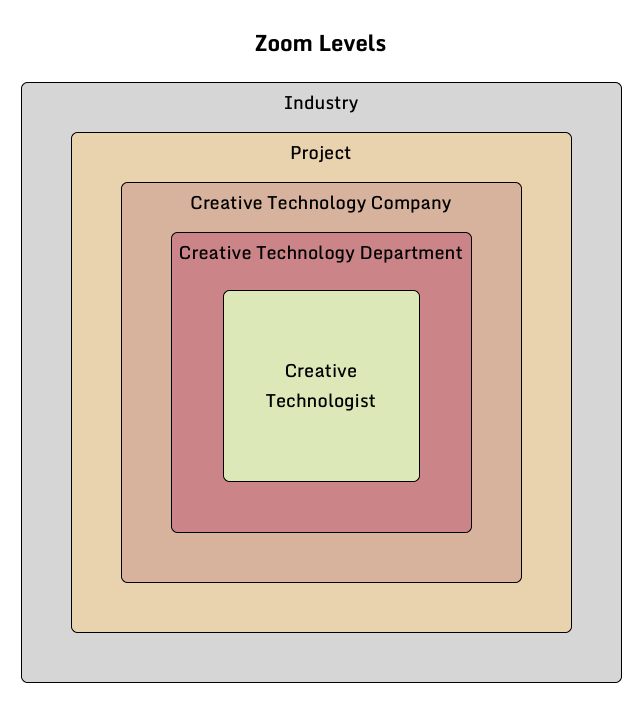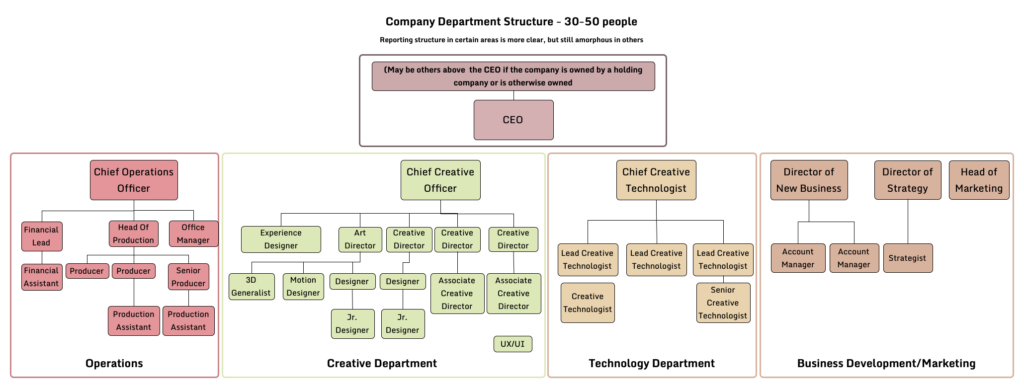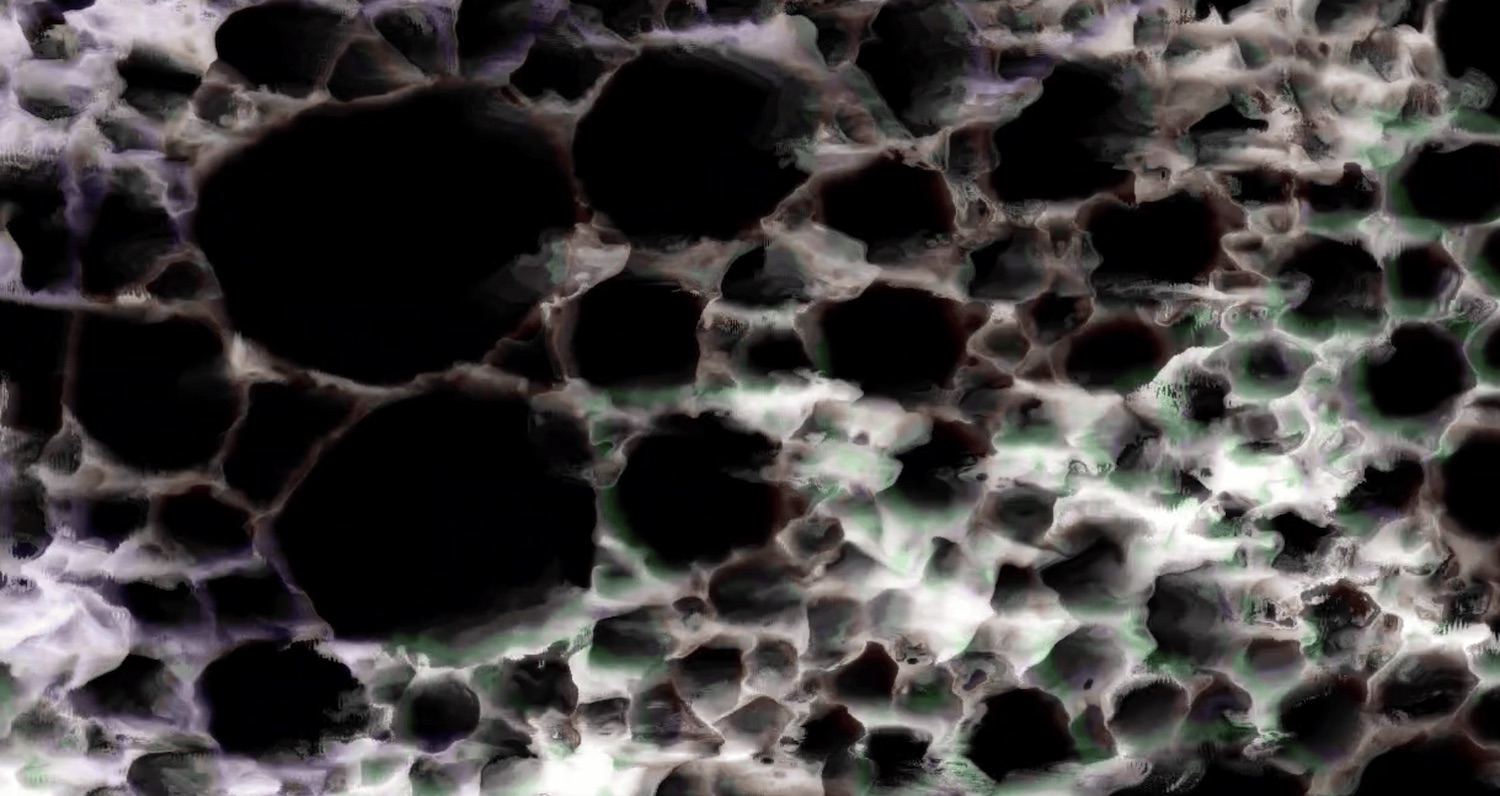Experience Design and Creative Technology projects and companies can be an exhilarating mess sometimes.
This is not a problem unique to any one company - the “behind the scenes” processes of bringing incredible experience design work to life often feels frustrating to the people that do the work in companies large and small. Many projects have big creative visions, tight timelines, tighter budgets, move quickly, have vaguely defined boundaries, and are often working with cutting edge technology that inherently doesn’t have a clear path of efficiently working with it. No judgment - it is a really hard problem, and we could all use a bit of perspective sometimes.
In this multi-part series, I'm going to explore and reflect on different detail levels of the various organizational structures I've observed while working on professional creative technology and experience design projects. I believe that for everyone to do better work, Creative Technology needs more leaders thinking broadly and organizationally, not just on an executional “just make the thing” project level. These essays will be looking at this topic primarily from my personal perspective of working in creative technology in an advertising and experience design space, but I think there are some valuable insights for anyone working in the experience design field - producers, creatives, strategists, etc.
To be up front - I have struggled with the “who is the audience” for this piece, but wanted to finally share it out regardless. My hope is that students and newcomers can get a peek inside the industry and see where they might want to land, and department leads can get some perspective on how different companies approach the issue of process and structure, project managers can better understand the nuances of creative tech resourcing (i.e. freelancers vs staff, varied irregular skill sets). I think that by considering the role that you and creative technology play within your organization, you can start to think more operationally about how to improve your process and work more effectively with other teams and clients.
Overview of Upcoming Essay parts:

Interrogating the systems involved at multiple levels of detail can (hopefully) help us improve the ways that we work together, but this multi-level view can also give us a way to grapple with some of the real challenges of this kind of work.
In Part 1 (this part), I’ll actually start at the company level to provide some broader context first.
In Part 2, I’ll be exploring the micro level of just a hypothetical Creative Technology department within a company
Part 3 zooms out to the project level to bring it all together. We’ll look at the company within a project and compare direct-to-client versus an agency experience. It will make sense in the end, I promise.
For Part 4, I'll cover my perspective of how other industries "feed" the creative technology space and ecosystem - i.e. where do new technologies originate from and how do they become common tools for use in various creative technology applications?
In Part 5 (also at a later date), we'll actually turn inward a bit and cover some more philosophical points about how someone's personal (or a company’s) hierarchy of values will influence the work that is being created.
I think the value of looking at this field from these different levels is that it can help give some perspective from the day to day noise, and allow us to think about how to bring more meaning to what we do and how we collaborate.
Preamble: What do you mean by Creative Technology?
“Creative Technologist” is still a job title that many find hard to describe. The title ends up meaning very different things at different companies, and it can be hard to pin down what creative technologists could and should be doing within an organization.
For newcomers to creative technology, when I'm (personally) speaking about creative technology I mean projects that involve a wide range of things like: data-driven generative visuals on large LED walls, cameras and AI, buzzy buzzword technology activations, tried and true thoughtful and artful tech, interactive installations with sensors and robots, experiences that incorporate technology in creative ways, etc. There is a wide spectrum of work from pre-rendered assets to generative real time systems, and physical interactions to web-based interactions. The projects come to life at events, online, as mobile apps, as physical installations at museums, corporate lobbies, public spaces, and many other places.
When attempting to explain to my parents or other folks what I do as a Creative Technologist, I recently find myself reaching for this explanation:
I am an artist, and just like a painter’s medium is the full range of paint types and canvases, my medium is technology itself. I am considering the full offerings of hardware and software - their strengths, their weaknesses, their user experience, their reliability and many other factors. I look at the strategy, the concept, the timeline, the team, the landscape of technology and make informed choices about what technologies could be utilized to make the most enjoyable and thoughtful experience for a user. I also make and implement those choices to bring an actual project to life. In my personal experience, so much of what I do is about the theater of experience and picking and choosing technologies to bring that vision to life in thoughtful ways that honor the person experiencing something and the team creating it. Keeping things simple and letting the technology support the concept are some guiding principles.
For more overall context on what creative technology encompasses, check out this taxonomy I created and my advice for creative technologists.
Part 1: Structure Overview
Company Structure
Let’s first take a look at the broad range of organizations that may have creative technology as part of their offering. There can be a range of things to consider here, like degree of freedom in the work and whether you have clients or no clients at all. Depending on the size and "flavor" of your given organization's focus, your overall structure may be radically different. First - let's consider the range of organizations that creative technologists often find themselves in:
- Solo Artist or Freelance Creative Technologist
- Doing your own work or contracting with a company. Nobody can tie you down.
- Artist's Studio
- Working for a big name artist or a person who has a particular way of working
- Startup
- Maybe an experience design company, or maybe more product focused (or both)
- Agency
- Advertising or otherwise. This is a fairly fluid category where the ratio of “idea making” to “real making” can vary wildly within each agency. Some agencies just make ideas and hire talented partners to help bring them to life, and some are full-service and do everything from strategy, concept to execution.
- Firm
- Architectural, Design Firm, Design Consultancy, etc. Some minor differences from an agency, but most of that can perhaps be a semantic exercise.
- Studio
- Fine line between what you would consider a studio versus an agency - perhaps these do more work for cultural institutions
- Production Company
- Handling many aspects of a complete production, but often are closer to execution of the idea than the original concept creation of that idea.
- Brand
- Brands sometimes have their own "innovation labs" that do creative tech R&D
- Product
- Some startups or products start in a sort of “Design Innovation” stage and need creative technology to bring it to life
- Content Studio
- Primarily concerned with making digital assets like motion graphics, but many of these are beginning to bleed into experience and have their own creative technology departments
- Live Visuals and technology for Touring Music Acts/Theater Productions
- Primarily things that fall outside of the scope of typical lighting/sound tech
- Many others...
Personally, I primarily have experience with the agency model, but most companies have somewhat similar structures and types of departments. The differences seem to mostly be in labels, and the overall scale of the other departments. There are also often echoes of whether a company started off as something else and then eventually integrated or bolted on a creative technology department. For example, a company that was originally a motion graphics company may have a lot more motion graphics artists, art directors, and creatives than a company that was originally more of an architecture firm that may not have as much content creation as a core offering.
Starting from the top, a CEO/Founder or a few founders will typically be the key decision makers. Next up, an Operations and/or Production department handles everything that makes the business run smoothly - financials, project management, process, hiring, contracts and legal, etc. The Creative team handles everything from concepts to copywriting, art direction, and asset creation. The Technology team may be a mix of engineers and more "Creative Technologists." There is also often a Business Development team that helps to bring in new work and grow existing relationships. Strategy is a mixed bag of whether it exists as its own discipline at different agencies depending on the size - some creatives are expected to think like strategists, but it really is its own speciality that works to clearly connect creative work to business goals.


There are lots of different ways to carve up these departments and their purpose, and there are certainly other departments that could be added to or divided in different ways - architectural, PR, design, UX, systems, etc. The important thing to note here is that each department typically has their own goals and levels of success measurement that (hopefully) ladder up to some larger company goals and values. Creative Technology departments don't succeed all on their own, they need some mix of help from many other specialties.
Also - as you can see above, there are some big hypothetical differences when scaling up from just a few people to a much larger team. Some companies may have a totally lopsided structure that indexes much more in one area and farms the rest out to other companies and trusted partners, etc. and the diagrams above are really meant more to illustrate potential structures at play.
Finally, I'll end part 1 on some provocations and questions that I feel come up a lot at this sort of level. While I could provide my own answers and insights for each of these, I feel like it would make this exercise overly long - but perhaps one day I'll do a breakout of my own thoughts on each of these.
Questions for Department Leads to consider at the Company level:
- How can the Creative Technology team work most effectively with other departments?
- Can budget and timing estimates get more accurate for the production team?
- Can workflows and technical hurdles be more clearly explained to the creative teams so that there are less misunderstandings as the project starts to take shape?
- Can concept prototypes be made more quickly so the business development team can sell through an idea to a client?
- Is it worth it to do a risk assessment of a project and consider all unknowns and points of failure ahead of starting so that all teams are on the same page about where things may need to pivot later on?
- How can other departments work most effectively with the creative technology team?
- What boundaries are necessary around a typical development cycle and result in the “best” product?
- If a waterfall development method isn't yielding appropriate results, how can all departments adjust their approach to allow more time for testing and iteration?
- How can other teams work more collaboratively to understand the challenges facing certain technology solutions and work together to find an ideal solution?
- Are departments more effective when they "stay in their lane" and are siloed, or when they are cross-functional and interdisciplinary? What is the line of crossover?
- What is the role of research and development work for the creative tech team and how should that work be disseminated amongst the other teams?
- Why don't companies more openly share things like org charts and the way they work (either internally or externally)? Is it a sign of a secret sauce, a lack of structure, or just that there may be limited value to others?
- Is the creative tech team a "core" offering for the company that the rest of the company is truly investing in, or does it seem like more of a curiosity with a short shelf life for the company?
- What parts of producing a creative technology project are unique? What additional skills would you want a project manager or producer to have if they are coming to join the team from an events background/software background/content production background?
- How can you effectively add in a "typical" software development cycle approach to a shop/company/team that is used to working in a different way? Does the software process need to adjust more than the rest? Where can everyone compromise?
In part 2, we will cover more of the details around an actual creative technology department within a company. And in Part 3 we'll look at both that department and the company as a whole within the larger ecosystem of a company. Links will update here in the coming weeks.
Acknowledgements
I've actually been sitting on this set of essays for a little over 2 years, and I've been sharing it privately over the course of those few years and soliciting encouragement and feedback. I've gotten a ton of useful notes from a number of peers and friends (some of whom may not even remember helping out!) that I wanted to acknowledge sooner than later since it may take some time to publish the last few parts.
- Mary Franck
- Eric Zhao
- Joshue Ott
- Golan Levin
- Raphael Palefsky-Smith
- Sundar Raman
- Rick Barazza
- Erik Karasyk
- Ben Bojko
- and many others! Thanks everyone!

[…] is a sort of continuation on my essays on creative tech and organizational structures, but could easily be considered its own […]
[…] Other great links to check out at the top of the article: List of Creative Tech companies and Creative Tech and Organizational Structures […]
[…] to previous parts: Part 1 and Part […]
[…] Link to Previous Part: Intro and Part 1 […]